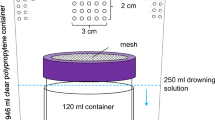Abstract
The chemical mediation of host-finding was investigated for the dusky sap beetle,Carpophilus lugubris Murray. GC-MS analysis of the headspace volatiles above whole-wheat bread dough inoculated with baker's yeast, a substrate previously determined to be an effective attractant, revealed seven major components in the following order of decreasing concentration: ethanol, acetaldehyde, 2-methylpropanol, 3-methylbutanol, propanol, 2-methylbutanol, and ethyl acetate. Solutions of these seven compounds blended so as to mimic the odor of whole-wheat bread dough elicited upwind orientation from 1.8 m in a wind tunnel byC. lugubris at a level comparable to that elicited by the bread dough. A series of bioassays investigating the role of individual components from the synthetic blend determined that all seven compounds contributed to behavioral activity; however, the simplest blend evoking attraction comparable to bread dough included acetaldehyde, ethyl acetate, 2-methylpropanol, and 3-methylbutanol. Of these compounds, acetaldehyde was essential, ethyl acetate was interchangeable with ethanol or partially replaceable with propanol, and 2-methylpropanol and 3-methylbutanol were partially replaceable with a combination of the other alcohols. Headspace volatiles above aseptic or fungus-inoculated tomato, banana, sweet corn, and strawberry were also qualitatively and quantitatively analyzed. This study suggests thatC. lugubris locates its food sources by response to variable blends of common volatile constituents of plants and fungi.
Similar content being viewed by others
References
Alexopoulos, C.J. 1979. Introductory Mycology, 3rd ed. John Wiley & Sons, New York.
Alm, S.R., Hall, F.R., Ladd, T.L., Jr., andWilliams, R.N. 1985. A chemical attractant forGlischrochilus quadrisignatus (Coleoptera: Nitidulidae).J. Econ. Entomol. 78:839–843.
Appel, D.N., Andersen, K., andLewis, R. 1986. Occurrence of nitidulid beetles (Coleoptera: Nitidulidae) in Texas oak wilt centers.J. Econ. Entomol. 79:1276–1279.
Bartelt, R.J., Dowd, P.F., andPlattner, R.D. 1990. The aggregation pheromone ofCarpophilus lugubris: Toward new pest management tools for the nitidulid beetles, pp. 27–40,in P.A. Hedin (ed.). Naturally Occurring Pest Bioregulators. American Chemical Society, Washington, D.C.
Blackmer, J., andPhelan, P.L. 1991. Effect of physiological state and fungal inoculation on chemically modulated host-plant finding byCarpophilus hemipterus andCarpophilus lugubris.Entomol. Exp. Appl. 58:137–148.
Connell, W.A. 1975. Hosts ofCarpophilus dimidiatus.J. Econ. Entomol. 68:279–280.
Dicke, M. 1988. Microbial allelochemicals affecting the behavior of insects, mites, nematodes, and protozoa in different trophic levels, pp. 125–162,in P. Barbosa and D.K. Letourneau (eds.). Novel Aspects of Insect-Plant Interactions. John Wiley & Sons, New York.
Dorsey, C.K., andLeach, J.G. 1956. The bionomics of certain insects associated with oak wilt with particular reference to the Nitidulidae.J. Econ. Entomol. 49:219–230.
Dorsey, C.K., Jewell, F.F., Leach, J.G., andTrue, R.P. 1953. Experimental transmission of oak wilt by four species of nitidulidae.Plant Dis. Rep. 37:419–420.
Hall, R.W., Smilanick, J.M., andEhler, L.E. 1978. Laboratory rearing and field observation onCarpophilus mutilatus.Ann. Entomol. Soc. Am. 71:408–410.
Harrison, F.P. 1962. Infestation of sweet corn by the dusky sap beetle,Carpophilus lugubris.J. Econ. Entomol. 55:922–925.
Harrison, F.P. 1974. Chemical control of ear-infesting insects of sweet corn.J. Econ. Entomol. 67:548–550.
Maarse, H., andVisscher, C.A. 1988. Volatile Compounds in Food: Quantitative Data, Vol. 7. TNO-CNO Food Analysis Institute, Zeist, The Netherlands.
Neel, W.W., Glick, B.D., May, L.L., andTrue, R.P. 1967. Attractiveness to Nitidulidae (Coleoptera) of natural attrahents of tree and fungus origin supplemented with vinegar and water in an Appalachian hardwood forest.J. Econ. Entomol. 60:1104–1109.
Phelan, P.L., andLin, H. 1991. Chemical characterization of fruit and fungal volatiles attractive to dried-fruit beetle,Carpophilus hemipterus (L.) (Coleoptera: Nitidulidae).J. Chem. Ecol. 17:1253–1272.
Phelan, P.L., Roelofs, C.J., Youngman, R.R., andBaker, T.C. 1991. Characterization of chemicals mediating ovipositional host-plant finding byAmyelois transitella females.J. Chem. Ecol. 17:599–613.
Peng, C., andWilliams, R.N. 1991. Effect of trap design, trap height and habitat on the capture of sap beetles (Coleoptera: Nitidulidae) using whole wheat bread dough.J. Econ. Entomol. In press.
SAS Institute. 1985. SAS User's Guide: Statistics. SAS Institute, Cary, North Carolina.
Sanford, J.W., andLuckmann, W.H. 1963. Observations on the biology and control of the dusky sap beetle in Illinois.Proc. North Central Branch E.S.A. 18:39–43.
Smilanick, J.M., Ehler, L.E., andBirch, M.C. 1978. Attraction ofCarpophilus spp. (Coleoptera: Nitidulidae) to volatile compounds present in figs.J. Chem. Ecol. 4:701–707.
Visser, J.H. 1986. Host odor perception in phytophagous insects.Annu. Rev. Entomol. 31:121–144.
Wildman, J.D. 1933. Note on the use of microorganisms for the production of odors attractive to the dried fruit beetle.J. Econ. Entomol. 26:516–517.
Author information
Authors and Affiliations
Rights and permissions
About this article
Cite this article
Lin, H., Phelan, P.L. Identification of food volatiles attractive to dusky sap beetle,Carpophilus lugubris (Coleoptera: Nitidulidae). J Chem Ecol 17, 1273–1286 (1991). https://doi.org/10.1007/BF01402949
Received:
Accepted:
Issue Date:
DOI: https://doi.org/10.1007/BF01402949




